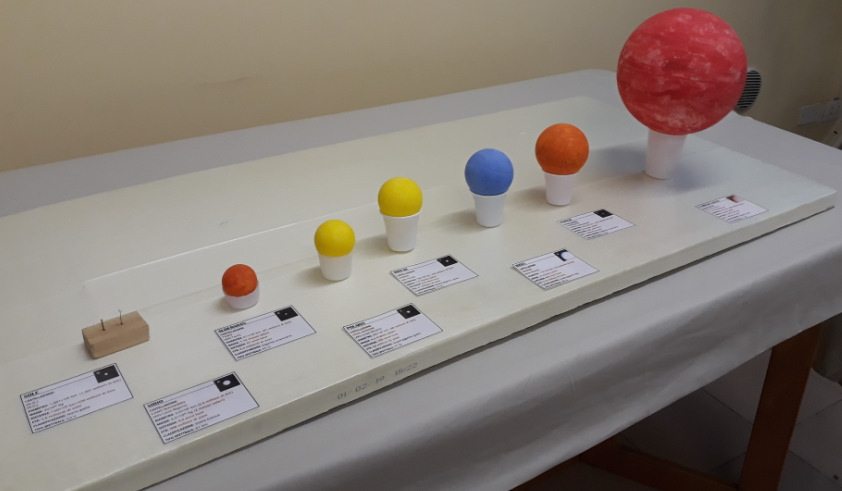
[Please share feedback or suggestions on this activity to IAU-InclusiveOutreach@uai.it]
Description
This tool is composed of a set of polystyrene spheres representing stars of various sizes.
The unit of measurement chosen is the diameter of the Sun, which is represented by a sphere 1mm in diameter.
With this scale, the various types of stars, from dwarfs to supergiants, are simulated with manageable-sized spheres.
In the set described here, the largest star considered is Y Canum Venaticorum, but even bigger stars (e.g., Betelgeuse or UY Scuti) can be simulated using inflatable balls.
Objectives
To allow the participants to contextualize the different dimensions and the respective proportions of some stars with respect to the Sun, and between the stars.
Material
- 10 Polystyrene spheres and other materials depicting ten stars
- Sun: 1mm, yellow
- Sirius: 2mm, white
- Aldebaran: 4cm, orange
- Polaris: 5cm, yellow
- Mirfak: 6cm, yellow
- Rigel. 7cm, light blue
- Almak: 8cm, orange
- Y Canum Venaticorum: 20cm, red
- Tempera colors
Preparation
The scale used for this tool is 1 mm : 1,391,000 km (average diameter of the Sun). This scale is needed to be able to include the sizes of all of the stars. The reference stars used are, in order by size: Sun (1mm ball, yellow), Sirius (2mm ball, white), Aldebaran (4cm ball, orange), Polaris (5cm ball, yellow), Mirfak (6cm ball, yellow), Rigel (7cm sphere, blue), Almak (8cm sphere, orange), Y Canum Venaticorum (20cm sphere, red). The stars are colored using tempera colors that represent color temperatures of the stars.
Procedure
- Step 1: Explanation of the Sun, explanation of what a star is, and display 1 mm ball (the size of the Sun)
- Step 2: Point out that the size of the Sun on this scale, the size of a planet, of the Earth, are imperceptible. Introduce the final step in the evolution of these types of stars (white dwarf)
- Step 3: The participant holds the Sun in one hand and is then given the next sphere, representing the star Sirius. Compare the sizes of the two stars. Introduce the idea of stars having different sizes.
- Step 4: The participant holds the Sun in one hand and is given the next sphere, representing the star Aldebaran. Compare the sizes of the two stars. Using Aldebaran, introduce the idea that stars have different colors.
- Step 5: The participant holds the Sun in one hand and is given the next sphere, that of Polaris. Compare the sizes of the two stars. Using Polaris, introduce the concept of double stars.
Step 6: The participant holds the Sun in one hand and is given the next sphere, that of the star Mirfak. Compare the sizes of the two stars. Using Mirfak, introduce the final stage of evolution of these types of stars (supernova). - Step 7: The participant holds the Sun in one hand and is given the next sphere, that of the star Rigel. Compare the sizes of the two stars. Using Rigel, explain blue supergiants.
- Step 8: The participant holds the Sun in one hand and is given the next sphere, that of the star Almak. Compare the sizes of the two stars. Using the star Almak, explain multiple star systems.
- Step 9: The participant holds the Sun in one hand and is given the next sphere, that of the star Y Canum Venaticorum. Compare the sizes of the two stars. Describe the star named by Angelo Secchi “La Superba.”
- Step 10: The participant holds the Sun in one hand. Explain to the participant that the largest known star is the UY star of the constellation Scud with a diameter of 1708 million km. With the scale we are using, it would be a 1.7-meter sphere. It is currently the largest star in the Milky Way. If placed at the center of our solar system, the surface of the star would swallow Jupiter and reach 1 AU beyond Saturn.
Let’s analyze
Take the spheres of the various stars and place them on the table, and let the participant touch them:
- What do you remember about their sizes?
- Which star do you remember? Why?
- What do you imagine these stars would look like in a telescope?
- Explain why the stars are always seen as point-like. (ANSWER: the stars are so distant that they are only points of light that even the largest telescopes cannot magnify)
- Our human body is carbon-based. Where do we find carbon in the Universe? Explain the nuclear reaction process of the various elements of the periodic table. (ANSWER: All elements are produced inside the stars, except for the hydrogen that present at the beginning of the Universe.
- Stars are nuclear reactors that fuse elements, starting from hydrogen, to produce all the other elements, including the carbon we are made of.
Specifically, stars form all the elements from helium to iron during their lives, while all the elements heavier than iron are created during the explosion of a supernova)
